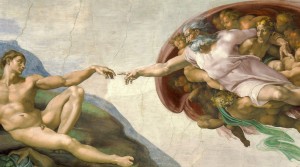 Every so often, probably a few times a year, I receive some sort of request to speak or write an article on a subject such as “heroes of modern leadership”. Coincidentally, this happened last week, just as I was preparing my post about Apple and the Hero Myth. Banco Galicia, an Argentine bank I work with, making speeches at their headquarters in Buenos Aires and writing for their website “Buenos Negocios”, proposed several topics for my next piece. One of them was about stories of heroism and leadership.
Every so often, probably a few times a year, I receive some sort of request to speak or write an article on a subject such as “heroes of modern leadership”. Coincidentally, this happened last week, just as I was preparing my post about Apple and the Hero Myth. Banco Galicia, an Argentine bank I work with, making speeches at their headquarters in Buenos Aires and writing for their website “Buenos Negocios”, proposed several topics for my next piece. One of them was about stories of heroism and leadership.
While I will certainly choose another theme from the list of suggested subjects for the article, their email did remind me once again how prevalent the Myth of the Hero is in our culture.
The desire to create mythical figures of superhuman propositions, to associate great achievement and historically significant events with a single person, seems deeply rooted in Western culture. We have long had the tendency to exaggerate the individual work of leaders, in all walks of life.
For example, we credit Michelangelo with painting the ceiling of the Sistine Chapel. In our minds, we picture one man, alone on the scaffolding high above the chapel floor, laboring at all hours of the day and night to meet a deadline imposed by the pope.
But, this image of a prodigious individual working alone on this valiant initiative is more Hollywood than reality. In actual fact, and as described by biographer William E. Wallace, 13 people had significant roles in the grandiose effort that produced the ceiling of the famous chapel. Wallace wrote that Michelangelo was far more than an artist; in modern terms, we would say that he was the CEO of a good-sized, and highly efficient, entrepreneurial enterprise.
As such, I have long found the subject “heroes of modern leadership” both interesting and controversial. As I wrote last week, I refer often in my work to the ‘myth of the hero’, our fascination with the solitary charismatic figure who can ‘change the weather’, as Winston Churchill claimed his ancestor John Churchill could. We cling to the myth of the single great man because we want to believe in larger-than-life figures capable of inspiring us and leading us to the Promised Land.
The reality of any outstanding accomplishment is always somewhat more complex. Leaders do not change the world, the weather, or their organizations on their own. In nearly all cases, leadership is a transaction between a leader, a group of followers, and a vision of what they can achieve together. Leaders and followers become allies in support of a common cause, and they develop together a shared sense of meaning and purpose.
My own image of heroic leadership is inspired by a quote from Carlos Ghosn. When asked about the difference between a good leader and a great one, the Renault and Nissan CEO opined: “A good leader brings results. A great leader writes a new story.”
To me, if there is such a thing as a “leader-hero”, it is not the larger-than-life figure we imagine painting the ceiling of the Sistine Chapel, or singlehandedly imposing insane standards of excellence at Apple Inc. Rather, it is someone who succeeds at writing a new story for an organization, a story of change that brings the company and its people to a new place. In the most striking cases, that story is simple, authentic, and engaging for the followers. It binds the group together by providing vision, meaning and purpose.
One of the elements of the Steve Jobs story that I find most interesting is how much he evolved between two key moments in his life: 1985, when he was forced out of the company, and 1998 when he returned. The Jobs of the early ‘80s focused single-mindedly on shaping amazing products. During this period, he wanted to control development himself, and he micro-managed with great fanfare. To my mind, he very much sought to play the role of the Hero.
Upon his return in 1998, he was interested in a more far-reaching project than product development. His Pixar experience, in particular, had helped him to see that great companies had unique and robust cultures. While his impact in the company remained extraordinary, he now knew that he could not do so much on his own. He needed to engage a core group that could build great products, even when he was no longer there.
His goal was to forge a new story of collective identity for the company, to build a culture that would allow Apple to remain great, and even become legendary.
Image: Flickr-user Jörg Lohrer
